Halogen-doped lead chalcogenide nanometer crystal and preparation method and application thereof
A compound and nanocrystal technology, applied in photovoltaic power generation, electrical components, circuits, etc., can solve the problems of rare n-type PbY nanocrystals, and achieve the effect of increasing the thickness of the active layer, increasing the built-in electric field, and simple preparation method.
- Summary
- Abstract
- Description
- Claims
- Application Information
AI Technical Summary
Problems solved by technology
Method used
Image
Examples
Embodiment 1
[0039] Example 1: Preparation of chlorine-doped PbS nanocrystals.
[0040] 1) Add 223mg (1mmol) of lead oxide, 700mg (2.5mmol) of oleic acid and 10g of 1-octadecene into a three-necked flask, stir and vacuumize at 100°C for 1 hour to obtain a lead precursor, which is ready for use;
[0041] 2) Nitrogen was introduced into the three-necked flask, and the temperature was adjusted to 120°C, 8.75 μL (0.1 mmol) TMSCl, 105 μL (0.5 mmol) (TMS) 2 After mixing S and 5mL 1-octadecene evenly, quickly inject it into the above-mentioned lead precursor with a syringe, and continue to react for 5 minutes;
[0042]3) After the reaction is completed, lower the water bath to room temperature, inject 8 mL of anhydrous n-hexane, transfer the reaction solution to a centrifuge tube, add isopropanol until the reaction solution becomes cloudy, centrifuge for 5 minutes in a centrifuge (8000 rpm), discard Remove the upper layer, then dissolve it with n-hexane, add acetone and centrifuge, discard the u...
Embodiment 2
[0043] Example 2: Preparation of chlorine-doped PbS nanocrystals.
[0044] 1) Add 223mg (1mmol) of lead oxide, 700mg (2.5mmol) of oleic acid and 10g of 1-octadecene into a three-necked flask, stir and vacuumize at 110°C for 2 hours to obtain a lead precursor, which is ready for use;
[0045] 2) Nitrogen was introduced into the three-necked flask, and the temperature was adjusted to 120°C, and 17.5 μL (0.2 mmol) TMSCl, 105 μL (0.5 mmol) (TMS) 2 After mixing S and 5mL 1-octadecene evenly, quickly inject it into the above-mentioned lead precursor with a syringe, and continue to react for 5 minutes;
[0046] 3) After the reaction is completed, lower the water bath to room temperature, inject 8 mL of anhydrous n-hexane, transfer the reaction solution to a centrifuge tube, add isopropanol until the reaction solution becomes cloudy, centrifuge for 5 minutes in a centrifuge (8000 rpm), discard Remove the upper layer, then dissolve it with n-hexane, add acetone and centrifuge, discard...
Embodiment 3
[0047] Example 3: Preparation of chlorine-doped PbS nanocrystals.
[0048] 1) Add 223mg (1mmol) of lead oxide, 700mg (2.5mmol) of oleic acid and 10g of 1-octadecene into a three-necked flask, stir and vacuumize at 110°C for 1 hour to obtain a lead precursor, which is ready for use;
[0049] 2) Nitrogen was introduced into the three-necked flask, and the temperature was adjusted to 120°C, 27 μL (0.3 mmol) TMSCl, 105 μL (0.5 mmol) (TMS) 2 After mixing S and 5mL 1-octadecene evenly, quickly inject it into the above-mentioned lead precursor with a syringe, and continue to react for 5 minutes;
[0050] 3) After the reaction is completed, lower the water bath to room temperature, inject 8 mL of anhydrous n-hexane, transfer the reaction solution to a centrifuge tube, add isopropanol until the reaction solution becomes cloudy, centrifuge for 5 minutes in a centrifuge (8000 rpm), discard Remove the upper layer, then dissolve it with n-hexane, add acetone and centrifuge, discard the up...
PUM
 Login to View More
Login to View More Abstract
Description
Claims
Application Information
 Login to View More
Login to View More - R&D Engineer
- R&D Manager
- IP Professional
- Industry Leading Data Capabilities
- Powerful AI technology
- Patent DNA Extraction
Browse by: Latest US Patents, China's latest patents, Technical Efficacy Thesaurus, Application Domain, Technology Topic, Popular Technical Reports.
© 2024 PatSnap. All rights reserved.Legal|Privacy policy|Modern Slavery Act Transparency Statement|Sitemap|About US| Contact US: help@patsnap.com










